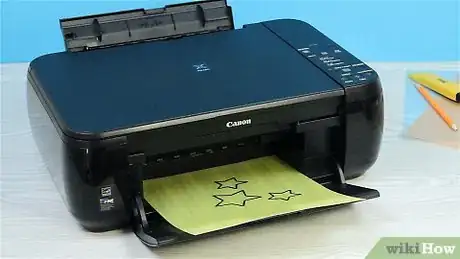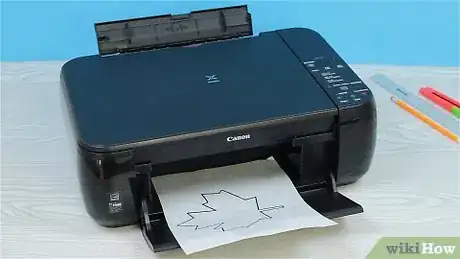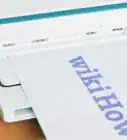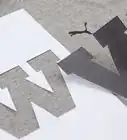This article was co-authored by wikiHow Staff. Our trained team of editors and researchers validate articles for accuracy and comprehensiveness. wikiHow's Content Management Team carefully monitors the work from our editorial staff to ensure that each article is backed by trusted research and meets our high quality standards.
There are 8 references cited in this article, which can be found at the bottom of the page.
This article has been viewed 129,160 times.
Learn more...
Stenciling is a fun way to add a personal touch to anything from blank walls to plain T-shirts. One of the most common materials for stencils is vinyl, because it’s sturdy and reusable. To create a vinyl stencil at home, choose and print your design, then cut it out with an X-Acto knife. And if you specifically want to decorate fabric, make one out of freezer paper instead, which allows you to easily secure the stencil to the fabric using an iron.
Things You Should Know
- Print the stencil design on vinyl and cut around it with an X-Acto knife. Then, tape the stencil on a flat surface and apply 2-3 coats of paint.
- Alternatively, trace the stencil on freezer paper and cut it out. Iron the stencil onto fabric and paint over the stencil with 2-3 coats of fabric paint.
- Let the paint dry for 24 hours before removing the stencil.
Steps
Creating a Basic Vinyl Stencil
-
1Print your stencil design on the vinyl if you have an inkjet printer. Place the vinyl into the tray of your inkjet printer just like you would with regular paper. Then print the stencil from your computer or laptop.
- Check your printer manual beforehand if you aren’t sure what type of printer you have or what types of paper or material are compatible with it.
- Never put vinyl in a laser printer. Because of its high temperature, it can melt the vinyl or distort the stencil.
- If you have a laser printer, print your design onto a sheet of regular paper. Then trace it onto the vinyl with a permanent marker.
Tips for Choosing a Stencil Design
If you’re a beginner, opt for a design without a lot of intricate cutouts or curved edges. Straight lines and simple shapes are easier to cut.
For a completely custom design, draw it yourself. Design your print directly on the vinyl, or draw it on a piece of paper first and transfer it.
If you want an oversized print, have it printed at a local printing shop or office store instead of trying to piece it together from your own printer.
-
2Use an X-Acto knife to cut out the stencil on a cutting mat. Carefully drag the blade around all of the edges, including any interior sections that need to be removed. Remember that any negative space will get painted.[1]
- Some stencils just require you to hold them down and that will help to keep it defined on the edge.
- To hold the stencil in place, you can tape it to the mat or ask someone to hold it for you while you cut.
- You can also use a stencil cutter or vinyl cutter if you have one.
- Set aside any of the inside sections that you’ll need later to create your design. For example, if you're cutting out a donut, keep the piece that you cut out of the inside. Otherwise, you'll end up with a filled-in circle instead of a donut.
Advertisement -
3Secure the stencil to your surface with tape. It will be difficult to hold the stencil in the same place the whole time you're painting. If it shifts at all, it will ruin the end result, so place tape on the outside edges of the stencil.[2]
- Use appropriate tape for whatever surface you’re painting. For example, if you’re stenciling a painted wall, use painter’s tape so it doesn’t damage the paint that’s already there.
-
4Paint 2 to 3 coats over the stencil, letting each coat dry in between. Thinner layers result in a more even color with fewer visible brushstrokes. Use a paintbrush or foam roller to cover all of the negative space in the stencil. Wait for the paint to dry before applying the next coat so you don’t smear the previous coat.[3]
- Stenciling is going to work based on the consistency of the paint, therefore the applied paint should not be too thick or thin.
- Be careful not to brush or roll too vigorously. You don’t want to shift the stencil or push paint under the edges.
- Choose your paint type based on the surface you're stenciling. For example, if you're decorating a wall, use interior wall paint or, if you're designing on ceramic, opt for acrylic paint.
- Spray paint is also a quick and easy option for stenciling.
-
5Let the paint dry for at least 24 hours before you remove the stencil. If you try to take off the stencil before the paint is completely dry, you’ll smear your hard work. Look on the paint can or package to find the recommended dry time, since it varies based on brand and type.[4]
- When your paint is fully dry, it shouldn’t be tacky to the touch. If it feels a little sticky, let it sit for longer.
Creative Ways to Use Your Stencil
Make an accent wall in your house with a bold pattern covering the entire wall.
Decorate furniture, like an end table or dresser, with pretty prints.
Use a small stencil to make homemade cards.
Stencil 1 large design on the wall for a piece of permanent wall art.
Design your own gift wrap by upgrading plain wrapping paper with stenciled patterns.
Making a Fabric Stencil
-
1Print your design onto the freezer paper if you have an inkjet printer. Load the freezer paper into your printer just as you would regular paper. Make sure that you print the design on the matte side of the paper.[5]
- Do not try to print on freezer paper with a laser printer. It will melt the paper and damage your printer. If you have a laser printer, print the design on regular paper, then trace it onto the freezer paper with a permanent marker.
-
2Cut out the design on a cutting mat, using an X-Acto knife. Hold the paper in place with 1 hand, then use the other to carefully cut along the border of your design with an X-Acto knife. Keep in mind that paint will go on any area you cut out.[6]
- Remove any sections on the inside of your design that you want to be painted, too.
- Taping the paper to the mat or having a friend hold it in place will make the cutting process easier.
- If you have a vinyl or craft cutter, you can use that instead of cutting the paper by hand.
How to Deal with Interior Cutouts
Label them with a piece of tape if you have multiple inside pieces. Otherwise you won’t know which cutout goes in which area of your stencil.
Use masking tape to hold cutouts in place when you’re stenciling. The iron won’t melt masking tape, so stick a rolled-up piece under the cutout before ironing.
Consider leaving them attached to the stencil. You can leave a tiny sliver of freezer paper linking the interior piece to the rest of the stencil. Keep in mind that this will show up when you paint it, though.
-
3Iron the stencil onto the fabric with the shiny side facing down. If you try to iron the stencil with the matte side down, the paper will stick to the iron instead of the shirt. Run the iron over the entire stencil, including the edges, to ensure it’s completely sealed to the fabric.[7]
- Don’t hold the iron in one place for longer than 5 to 10 seconds or you’ll melt the paper. Keep the iron moving over the stencil constantly.[8]
- Check for any gaps or loose edges. Paint will get under them, so if you notice any, iron those areas again.
-
4Place another sheet of freezer paper underneath the fabric. This protects whatever is underneath the fabric, and is especially important if you’re stenciling a T-shirt and don’t want the paint bleeding through to the other side. Make sure the entire area you’re painting is on top of the paper.[9]
- To prevent the paper from shifting while you paint, tape it to the underside of the fabric.
- A thick piece of cardboard or sheets of newspaper are both good alternatives to freezer paper for the protective layer.
-
5Dab 2 to 3 layers of permanent fabric paint over the stencil. Permanent paint won’t wash off in the laundry. Avoid painting with regular brushstrokes because it could push the paint under the stencil. Dabbing on a couple of thin layers with a paintbrush instead of 1 thick one will also prevent the stencil from becoming oversaturated and curling up.[10]
- How many coats you need depends on the color of the shirt and the paint. For example, if you’re using a light color or white paint on a dark shirt, you may need to do more coats to cover the color of the shirt.
- Let each coat dry before painting the next one.
- You can also buy a stencil brush instead of a regular paintbrush from a craft store or online retailer.
-
6Let the paint dry for at least 24 hours. Check the back of the paint bottle to find the dry time for that specific brand or type. If you aren’t sure, a good rule of thumb is to let the paint sit for 1 full day.[11]
- You can speed up the drying process by using a hair dryer to blow hot air over the paint.[12]
-
7Peel the stencil off of the fabric once the paint is dry. Removing the stencil while the paint is still wet could allow the paint to bleed, leaving your design with blurred or smeared edges. You should be able to pull the stencil off with your hands.[13]
- Use your X-Acto knife to carefully loosen any edges that are difficult to peel off.
- If you want to protect your painted stencil, you can place a thin cloth over the paint and iron it for 30 seconds. This sets the paint even further into the fabric.
Community Q&A
-
QuestionCan I use this method with small images or calligraphy?The method can be used to turn any image or lettering into a stencil. Keep in mind that the smaller the image, the more difficult it is to maintain detailed edges when cutting out the stencil.
-
QuestionCan I use paper for making the stencil?Paper absorbs paint and is not waterproof. If the stencil is a one-time use with a single coat of color, you can use a heavy weight paper for the stencil. Regular paper is too thin to make a decent stencil.
-
QuestionWhat material is used to make stencils?
 Drew Hawkins1Community AnswerYou can use vinyl or freezer paper to make a stencil. If you have a sheet of vinyl and draw or print out your design on it, then take an X-Acto knife to cut out the design. To use freezer paper, draw or print out your design, then place it on a cutting mat or cutting board and use an X-Acto knife to cut it out.
Drew Hawkins1Community AnswerYou can use vinyl or freezer paper to make a stencil. If you have a sheet of vinyl and draw or print out your design on it, then take an X-Acto knife to cut out the design. To use freezer paper, draw or print out your design, then place it on a cutting mat or cutting board and use an X-Acto knife to cut it out.
Things You’ll Need
Vinyl Stencil
- A sheet of vinyl
- X-Acto knife
- Cutting mat
- Paint
- Paintbrush or roller
- Tape
- Permanent marker (optional)
Fabric Stencil
- Wax paper
- Printer
- X-Acto knife
- Cutting mat
- Iron
- Fabric paint
- Paintbrush
- Thin cloth (optional)
- Permanent marker (optional)
References
- ↑ https://www.allthingsthrifty.com/how-to-make-a-huge-stencil-for-under-15/
- ↑ https://inksaver.co.za/blogs/blog/how-to-print-and-make-stencils-at-home
- ↑ https://www.redbookmag.com/home/decor/how-to/g266/design-stencils/?slide=5
- ↑ https://www.redbookmag.com/home/decor/how-to/g266/design-stencils/?slide=6
- ↑ https://www.happinessishomemade.net/freezer-paper-stenciling-tutorial/
- ↑ http://www.madeeveryday.com/2008/07/tutorial-freezer-paper-stencil-makenna-loves-goldfish.html/
- ↑ http://www.madeeveryday.com/2008/07/tutorial-freezer-paper-stencil-makenna-loves-goldfish.html/
- ↑ https://www.makelifelovely.com/freezer-paper-stencil-tutorial/
- ↑ https://www.happinessishomemade.net/freezer-paper-stenciling-tutorial/
About This Article
To make a basic vinyl stencil, start by printing your design onto a sheet of regular paper and tracing it onto some vinyl with a permanent marker. Alternatively, if you have an inkjet printer, you can place the vinyl into the tray like you would a regular piece of paper and print the stencil from your computer. Next, use an X-Acto knife, stencil cutter, or vinyl cutter to cut out the stencil on a cutting mat. Then, secure the stencil in place with painters tape, and apply 2 to 3 coats of paint to the material under the stencil. Finally, allow the paint to dry completely before removing the stencil. To learn how to make a fabric stencil, keep reading!

























































